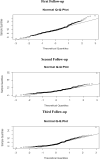Effect of Physical Activity and Dietary Changes on Management of Type 2 Diabetes Mellitus Patients: A Case-Control Study in Bangladesh
- PMID: 40372910
- PMCID: PMC12080536
- DOI: 10.1002/edm2.70051
Effect of Physical Activity and Dietary Changes on Management of Type 2 Diabetes Mellitus Patients: A Case-Control Study in Bangladesh
Abstract
Background: Type 2 diabetes mellitus (T2DM) is a growing public health issue in Bangladesh, projected to affect 13.7 million individuals by 2045. Physical inactivity and poor dietary habits increase the risk of complications. This study examined the effects of physical activity and lifestyle modifications on T2DM management.
Methods: A case-control study was conducted at Manikganj District Diabetic Hospital with 334 T2DM patients (aged 45-60 years). The case group (n = 167) followed structured physical activity and dietary modifications, while the control group (n = 167) did not. Data on socio-demographics, lifestyle and glycaemic markers-fasting plasma glucose (FPG), postprandial plasma glucose (PPG) and HbA1c-were collected at baseline, 3 months and 6 months. Chi-square tests and ordinal logistic regression models assessed associations between lifestyle factors and glycaemic outcomes.
Results: The control group had significantly higher plasma glucose levels, associated with gender (p < 0.001), treatment type (p = 0.004), medical adherence (p = 0.009), food habits (p = 0.007) and BMI (p = 0.005). The case group showed a significant FPG reduction from 10.035 mmol/L to 6.261 mmol/L (p < 0.001), with similar trends for PPG and HbA1c. Males had 1.8 times higher odds of elevated FPG, while poor adherence increased this risk 2.5-fold.
Conclusions: Lifestyle modifications significantly improve glycaemic control in T2DM patients. Strengthening adherence to medical advice and integrating structured interventions into routine care could enhance diabetes management in Bangladesh.
Keywords: Bangladesh; glycaemic control; lifestyle modifications; physical activity; type 2 diabetes mellitus (T2DM).
© 2025 The Author(s). Endocrinology, Diabetes & Metabolism published by John Wiley & Sons Ltd.
Conflict of interest statement
The authors declare no conflicts of interest.
Figures





Similar articles
-
The effectiveness of physical leisure time activities on glycaemic control in adult patients with diabetes type 2: A Systematic Review.JBI Libr Syst Rev. 2012;10(42 Suppl):1-20. doi: 10.11124/jbisrir-2012-251. JBI Libr Syst Rev. 2012. PMID: 27820154
-
Postprandial peaks as a risk factor for cardiovascular disease: epidemiological perspectives.Int J Clin Pract Suppl. 2002 Jul;(129):5-11. Int J Clin Pract Suppl. 2002. PMID: 12166607 Review.
-
The Contribution of Postprandial Glucose Levels to Hyperglycemia in Type 2 Diabetes Calculated from Continuous Glucose Monitoring Data: Real World Evidence from the DIALECT-2 Cohort.Nutrients. 2024 Oct 20;16(20):3557. doi: 10.3390/nu16203557. Nutrients. 2024. PMID: 39458552 Free PMC article.
-
Association of diet and lifestyle with glycated haemoglobin in type 1 diabetes participants in the EURODIAB prospective complications study.Eur J Clin Nutr. 2016 Feb;70(2):229-36. doi: 10.1038/ejcn.2015.110. Epub 2015 Jul 15. Eur J Clin Nutr. 2016. PMID: 26173867
-
Clinical significance of targeting postprandial and fasting hyperglycemia in managing type 2 diabetes mellitus.Curr Med Res Opin. 2003;19(7):635-41. doi: 10.1185/030079903125002351. Curr Med Res Opin. 2003. PMID: 14606987 Review.
References
-
- Cho N. H., Shaw J. E., Karuranga S., et al., “IDF Diabetes Atlas: Global Estimates of Diabetes Prevalence for 2017 and Projections for 2045,” Diabetes Research and Clinical Practice 138 (2018): 271–281. - PubMed
-
- American Diabetes Association , “Classification and Diagnosis of Diabetes: Standards of Medical Care in Diabetes—2021,” Diabetes Care 44, no. 1 (2021): S15–S33. - PubMed
MeSH terms
Substances
LinkOut - more resources
Full Text Sources
Medical

